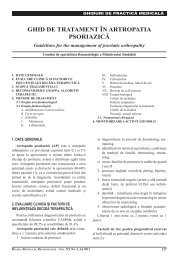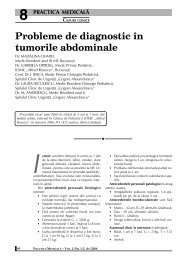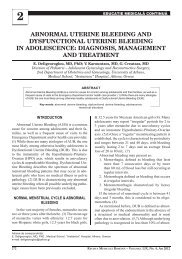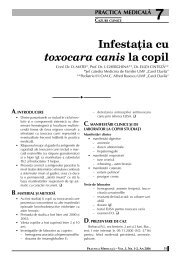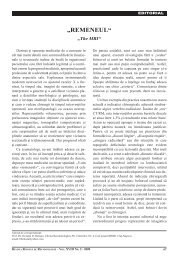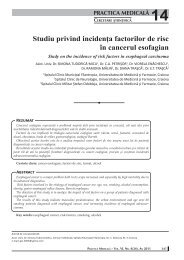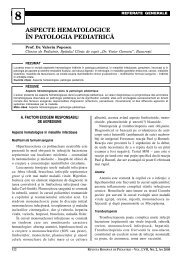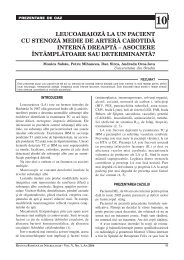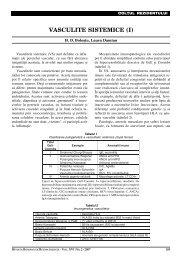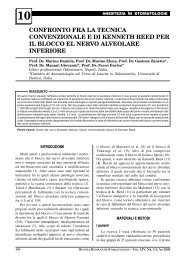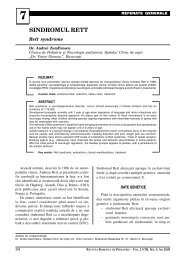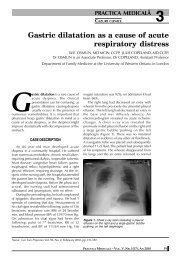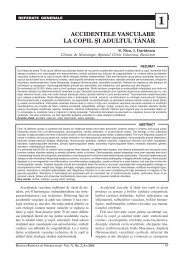Cuprins - medica.ro
Cuprins - medica.ro
Cuprins - medica.ro
Create successful ePaper yourself
Turn your PDF publications into a flip-book with our unique Google optimized e-Paper software.
REVISTA ROMÂNÅ DE STOMATOLOGIE – VOL. LIII, NR. 2, AN 2007<br />
personnel, and p<strong>ro</strong>fessional/technology occupations<br />
when compared to other occupations.<br />
Figure 1<br />
JNC7 classification and occupation category.<br />
As shown in Table 4, 22 (30%) of the diabetic<br />
subjects were not at goal or cont<strong>ro</strong>lled and 39<br />
(53.4%) had prehypertensive readings. This<br />
difference was statistically significant (p=.00).<br />
DISCUSSION<br />
Our results closely mir<strong>ro</strong>r those published in<br />
the literature which show a significant difference<br />
in hypertension prevalence when considering race,<br />
smoking habits, occupation, and diabetes.<br />
(1,2,5,7-10)<br />
93<br />
Table 3<br />
JNC7 classification and smoking<br />
Note: a Result of Chi square analysis reveals the difference between g<strong>ro</strong>ups is statistically<br />
significant: X 2(2, N=615)=6.8, p=0.03.<br />
Consistent with the current study, statistics f<strong>ro</strong>m<br />
the American Heart Association show African<br />
Americans have a higher average blood pressure<br />
than Caucasians.(4) Several authors also agree<br />
current smokers are at risk for systolic<br />
hypertension.(1,9) Unlike Zachariah et al., (11)<br />
the results of the present study found occupations<br />
involving moderate or greater physical activity was<br />
inversely associated with the prevalence of<br />
hypertension. In their study, more sedentary employees<br />
like office workers had more hypertension<br />
when compared to more physically active factory<br />
and assembly line workers.<br />
A particularly alarming finding in the current<br />
study shows 30% of diabetic subjects were not at<br />
goal or cont<strong>ro</strong>lled. Kaplan noted the combination<br />
of diabetes and hypertension adds to cardiovascular<br />
and renal damage, placing all diabetic<br />
hypertensives at increased risk for these conditions.(12)<br />
The most recent JNC7 guidelines are<br />
encouraging patients to maintain blood pressure<br />
readings lower than what it was considered normal<br />
a few years ago. The majority of records reviewed<br />
in this study reflected readings no longer<br />
considered normal. Even though the results of this<br />
study cannot be generalized to the entire population,<br />
they can be useful when planning modifications<br />
to the current dental hygiene clinic<br />
policy on assessing and interpreting blood pressure<br />
readings. The findings of this research p<strong>ro</strong>ject<br />
reiterate what has been p<strong>ro</strong>posed by the JNC7 and<br />
other authors who place emphasis on the need of<br />
increasing patients’ awareness about the dangers<br />
of hypertension.<br />
Table 4<br />
JNC7 classification and diabetes.<br />
Note: Result of Chi square analysis reveals that the difference between g<strong>ro</strong>ups is statistically<br />
significant: X 2 (4, N=606)=18.54, p=0.00.



